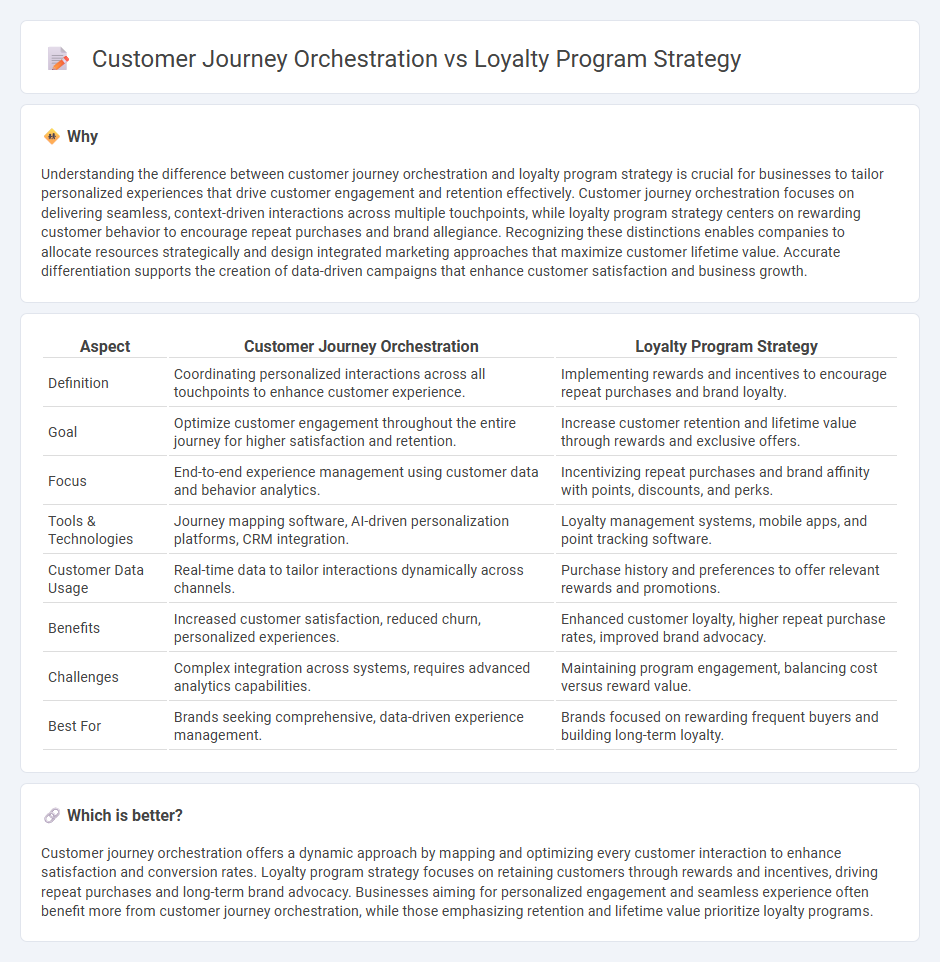
Customer journey orchestration involves designing seamless, personalized experiences across multiple touchpoints to enhance customer satisfaction and drive engagement. Loyalty program strategy focuses on incentivizing repeat purchases and fostering long-term brand loyalty through rewards and exclusive benefits. Explore how integrating both approaches can maximize customer retention and business growth.
Why it is important
Understanding the difference between customer journey orchestration and loyalty program strategy is crucial for businesses to tailor personalized experiences that drive customer engagement and retention effectively. Customer journey orchestration focuses on delivering seamless, context-driven interactions across multiple touchpoints, while loyalty program strategy centers on rewarding customer behavior to encourage repeat purchases and brand allegiance. Recognizing these distinctions enables companies to allocate resources strategically and design integrated marketing approaches that maximize customer lifetime value. Accurate differentiation supports the creation of data-driven campaigns that enhance customer satisfaction and business growth.
Comparison Table
| Aspect | Customer Journey Orchestration | Loyalty Program Strategy |
|---|---|---|
| Definition | Coordinating personalized interactions across all touchpoints to enhance customer experience. | Implementing rewards and incentives to encourage repeat purchases and brand loyalty. |
| Goal | Optimize customer engagement throughout the entire journey for higher satisfaction and retention. | Increase customer retention and lifetime value through rewards and exclusive offers. |
| Focus | End-to-end experience management using customer data and behavior analytics. | Incentivizing repeat purchases and brand affinity with points, discounts, and perks. |
| Tools & Technologies | Journey mapping software, AI-driven personalization platforms, CRM integration. | Loyalty management systems, mobile apps, and point tracking software. |
| Customer Data Usage | Real-time data to tailor interactions dynamically across channels. | Purchase history and preferences to offer relevant rewards and promotions. |
| Benefits | Increased customer satisfaction, reduced churn, personalized experiences. | Enhanced customer loyalty, higher repeat purchase rates, improved brand advocacy. |
| Challenges | Complex integration across systems, requires advanced analytics capabilities. | Maintaining program engagement, balancing cost versus reward value. |
| Best For | Brands seeking comprehensive, data-driven experience management. | Brands focused on rewarding frequent buyers and building long-term loyalty. |
Which is better?
Customer journey orchestration offers a dynamic approach by mapping and optimizing every customer interaction to enhance satisfaction and conversion rates. Loyalty program strategy focuses on retaining customers through rewards and incentives, driving repeat purchases and long-term brand advocacy. Businesses aiming for personalized engagement and seamless experience often benefit more from customer journey orchestration, while those emphasizing retention and lifetime value prioritize loyalty programs.
Connection
Customer journey orchestration drives personalized interactions that enhance customer engagement, directly influencing the effectiveness of loyalty program strategies by delivering tailored rewards and incentives. Integrating customer data across touchpoints ensures loyalty programs align with individual preferences, increasing retention and lifetime value. Strategic orchestration amplifies program relevance, fostering deeper emotional connections and sustained brand loyalty.
Key Terms
Loyalty Program Strategy:
Loyalty program strategy centers on designing targeted rewards and personalized incentives to enhance customer retention and increase lifetime value. It leverages data analytics to identify high-value segments and tailor offers that drive repeat purchases and brand allegiance. Explore how integrating a loyalty program strategy can transform your customer engagement and boost revenue growth.
Rewards Structure
A robust loyalty program strategy centers on designing a rewards structure that incentivizes repeat purchases through points, tiers, and exclusive benefits tailored to customer preferences. Customer journey orchestration integrates this rewards framework into personalized, real-time interactions by analyzing behavior across touchpoints to enhance engagement and retention. Explore how aligning rewards structure with journey orchestration can maximize customer lifetime value and brand loyalty.
Member Segmentation
Member segmentation in loyalty program strategy involves categorizing customers based on purchase behavior, engagement level, and demographic data to tailor rewards and increase retention rates. In customer journey orchestration, segmentation enhances personalized interactions by mapping touchpoints according to customer preferences and predicted lifecycle stages. Explore deeper insights into effective segmentation techniques and their impact on customer loyalty and experience.
Source and External Links
Designing a successful loyalty program strategy - A successful loyalty program strategy hinges on clear objectives aligned with business goals, a compelling value proposition beyond discounts, and deep customer insight to deliver uniquely relevant benefits that foster emotional connection and sustained engagement.
Loyalty programs: How they work, examples, and tips - Zendesk - Establishing specific goals, understanding customer needs, choosing the right program type, marketing effectively, and continuously reviewing performance are essential steps for implementing a successful loyalty program strategy focused on retention and customer experience enhancement.
Loyalty Programs Are Growing--So Are Customer Expectations - Leading loyalty programs drive innovation in customer activation, personalized experiences using AI and gamification, and strategic brand partnerships to deepen engagement and create active brand advocates in an increasingly competitive loyalty landscape.
 dowidth.com
dowidth.com